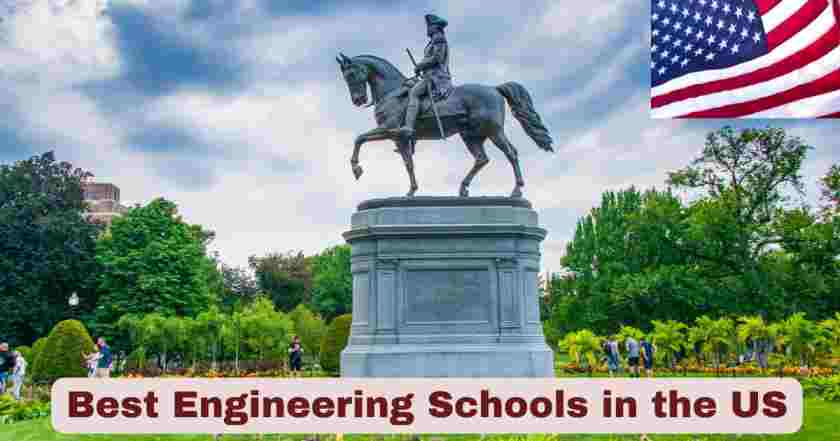Engineering Education in the US 2025
Engineering education in the United States continues to evolve with technological advancements, industry partnerships, and innovative curriculum design that defines the best engineering schools in the US 2025. The demand for skilled engineers has reached unprecedented levels, with over 300,000 engineering jobs projected to be added by 2030 across various disciplines including software, electrical, mechanical, and biomedical engineering. The nation’s 145 ranked engineering institutions compete to attract the brightest minds through cutting-edge research facilities, industry collaborations, and world-class faculty.
The landscape of engineering education has transformed significantly with the integration of artificial intelligence, machine learning, and sustainable technology into traditional engineering curricula. Students pursuing admission to the best engineering schools 2025 must demonstrate exceptional mathematical aptitude, creative problem-solving abilities, and strong foundation in STEM subjects. The average SAT score for top engineering programs has reached 1520-1570, while the average GPA stands at 3.8-4.0, reflecting the caliber of students entering these prestigious programs. These institutions serve as innovation hubs, producing graduates who will shape the future of technology, infrastructure, and sustainable development.
Interesting Facts and Latest Statistics about Engineering Schools in the US 2025
| Engineering School Facts Category | Key Statistics | Notable Details |
|---|---|---|
| Most Selective School | Stanford Engineering: 4% acceptance rate | MIT follows at 6.7% acceptance rate |
| Highest Research Funding | MIT: $838 million annually | Leads in federal research funding |
| Most Expensive Tuition | Stanford: $62,484 undergraduate | Private schools range $55,000-$65,000 |
| Best Value Public School | UC Berkeley: $14,226 in-state | World-class education at lower cost |
| Average Starting Salary | Engineering graduates: $75,000+ | Varies by specialty and location |
| Total Engineering Programs | 145 US institutions ranked | Over 400 ABET-accredited programs |
| Job Growth Projection | 300,000 new jobs by 2030 | 7% growth rate across specialties |
| International Students | 35% of graduate programs | Strong global representation |
The data reveals compelling insights about engineering education excellence and career prospects across American institutions. Stanford University’s School of Engineering maintains the most competitive admission process with only 4% acceptance rate, making it more selective than most prestigious undergraduate programs. This selectivity reflects the school’s Silicon Valley location and exceptional industry connections that provide unparalleled internship and career opportunities for graduates.
Research funding serves as a critical indicator of institutional quality and innovation capacity. MIT leads with $838 million in annual research funding, enabling groundbreaking projects in robotics, artificial intelligence, renewable energy, and bioengineering. This substantial investment translates into cutting-edge laboratories, world-class equipment, and opportunities for undergraduate students to participate in research that shapes entire industries. The 145 ranked US engineering institutions collectively receive over $15 billion in federal research funding annually, demonstrating America’s commitment to engineering innovation and technological leadership.
Best Engineering Schools in the US
| Rank | Engineering School | Acceptance Rate | Average SAT | Average GPA | Annual Tuition |
|---|---|---|---|---|---|
| 1 | Massachusetts Institute of Technology | 6.7% | 1570 | 4.17 | $59,750 |
| 2 | Stanford University | 4.0% | 1550 | 4.18 | $62,484 |
| 3 | University of California Berkeley | 27% | 1475 | 4.0 | $14,226 (In-state) |
| 4 | Carnegie Mellon University | 11% | 1520 | 3.97 | $63,829 |
| 5 | Georgia Institute of Technology | 17% | 1465 | 4.07 | $12,852 (In-state) |
| 6 | California Institute of Technology | 3.9% | 1560 | 4.19 | $60,816 |
| 7 | University of Michigan Ann Arbor | 18% | 1450 | 3.9 | $17,786 (In-state) |
| 8 | Cornell University | 7.3% | 1520 | 4.07 | $66,014 |
| 9 | University of Illinois Urbana-Champaign | 45% | 1440 | 3.83 | $19,714 (In-state) |
| 10 | Purdue University | 53% | 1420 | 3.74 | $10,948 (In-state) |
| 11 | University of Texas Austin | 31% | 1425 | 3.84 | $11,698 (In-state) |
| 12 | Northwestern University | 7.0% | 1520 | 4.09 | $64,887 |
| 13 | Princeton University | 4.4% | 1560 | 4.14 | $59,710 |
| 14 | University of California San Diego | 24% | 1430 | 4.08 | $14,648 (In-state) |
| 15 | Johns Hopkins University | 7.5% | 1530 | 4.04 | $62,840 |
1. Massachusetts Institute of Technology – Maintaining its position as the #1 engineering school in the US 2025, MIT combines cutting-edge research with practical innovation. The school’s 6.7% acceptance rate ensures exceptionally qualified students join rigorous programs. Students benefit from $838 million annual research funding and access to world-renowned facilities including the Computer Science and Artificial Intelligence Laboratory and Koch Institute for Integrative Cancer Research. The curriculum emphasizes hands-on learning through the famous “mens et manus” (mind and hand) philosophy. Research opportunities span from quantum computing to renewable energy. The $59,750 tuition represents substantial investment, but generous financial aid ensures accessibility for students from diverse economic backgrounds, with families earning under $90,000 paying no tuition.
2. Stanford University – With the lowest acceptance rate at 4.0%, Stanford represents the pinnacle of engineering education selectivity. The school’s Silicon Valley location provides unmatched opportunities for internships, entrepreneurship, and industry partnerships. Students gain access to state-of-the-art facilities including the Stanford Research Institute and d.school (Institute of Design). The interdisciplinary approach encourages collaboration across departments. Strong programs in computer science, bioengineering, and electrical engineering lead technological innovation. Recent initiatives include the $1.1 billion School of Engineering expansion and AI4ALL program promoting diversity in artificial intelligence. The $62,484 tuition reflects premium education quality, with robust financial aid supporting student diversity and accessibility.
3. University of California Berkeley – UC Berkeley offers world-class public engineering education with 27% acceptance rate providing relatively accessible admission to top-tier programs. The school’s College of Engineering consistently ranks among global leaders in multiple disciplines. Students benefit from diverse research opportunities spanning EECS, mechanical engineering, and bioengineering. The $14,226 in-state tuition provides exceptional value for California residents. Strong industry connections in Silicon Valley and Bay Area offer extensive internship and career opportunities. The Lawrence Berkeley National Laboratory affiliation provides unique research experiences. Recent achievements include breakthroughs in quantum computing, renewable energy, and biotechnology. Financial aid programs support students from diverse backgrounds pursuing engineering careers.
4. Carnegie Mellon University – Known for computer science and robotics excellence, Carnegie Mellon maintains 11% acceptance rate with selective admission standards. The school’s interdisciplinary approach combines engineering with computer science, design, and business. Students access the famous Robotics Institute and Software Engineering Institute. Strong programs in artificial intelligence, cybersecurity, and human-computer interaction lead industry innovation. The Pittsburgh location provides growing tech industry opportunities. Research opportunities include autonomous vehicles, machine learning, and digital transformation. The $63,829 tuition reflects premium education, with merit-based scholarships supporting exceptional students. Alumni include leaders at Google, Tesla, Apple, and major tech companies.
5. Georgia Institute of Technology – Georgia Tech offers exceptional value public education with 17% acceptance rate and strong industry connections. The school’s cooperative education program provides real-world experience with Fortune 500 companies. Students benefit from diverse engineering disciplines including aerospace, industrial, and environmental engineering. The $12,852 in-state tuition makes elite engineering education accessible. Strong programs in manufacturing, logistics, and technology management align with industry needs. The Atlanta location provides growing tech hub opportunities. Research initiatives focus on sustainable technology, advanced manufacturing, and digital innovation. The Yellow Jackets maintain strong alumni networks throughout aerospace, automotive, and technology industries.
6. California Institute of Technology – With 3.9% acceptance rate, Caltech represents ultimate engineering education selectivity and small class sizes. The school’s student-to-faculty ratio of 3:1 ensures personalized attention and mentorship. Students access JPL (Jet Propulsion Laboratory) for space exploration research. Strong programs in aerospace, chemical, and electrical engineering lead scientific discovery. The honor code system creates collaborative learning environment. Research opportunities include space exploration, quantum physics, and renewable energy. The $60,816 tuition includes access to world-class research facilities. The Pasadena location near JPL and aerospace industry provides unique career opportunities. Alumni include Nobel Prize winners and space exploration pioneers.
7-15. Other Top Engineering Schools – The remaining institutions (Michigan, Cornell, Illinois, Purdue, Texas, Northwestern, Princeton, UC San Diego, and Johns Hopkins) each offer unique strengths in research excellence, industry partnerships, and specialized programs. These schools maintain acceptance rates ranging from 4.4% to 53% depending on selectivity, with comprehensive programs preparing students for successful careers across all engineering disciplines including biomedical, environmental, civil, and emerging fields like renewable energy and biotechnology.
Engineering School Acceptance Rates and Competitiveness in the US 2025
| Competitiveness Level | Acceptance Rate Range | School Examples | Average SAT | Average GPA |
|---|---|---|---|---|
| Most Competitive | 3.9% – 7.5% | Caltech, Stanford, MIT, Princeton | 1550-1570 | 4.14-4.19 |
| Highly Competitive | 8.0% – 18% | Carnegie Mellon, Cornell, Georgia Tech | 1450-1520 | 3.90-4.09 |
| Very Competitive | 19% – 35% | UC Berkeley, UT Austin, UC San Diego | 1425-1475 | 3.84-4.08 |
| Competitive | 36% – 55% | Purdue, Illinois, Virginia Tech | 1380-1440 | 3.65-3.83 |
| National Average | 45% | All engineering programs | 1350 | 3.5 |
Engineering school acceptance rates 2025 demonstrate intense competition for admission to top-tier programs across the United States. The most elite institutions accept fewer than 8% of applicants, with Caltech setting the highest bar at 3.9% acceptance rate. This level of selectivity rivals the most competitive liberal arts programs and reflects the exceptional caliber of students pursuing engineering careers. Successful applicants to these top programs typically demonstrate outstanding mathematical aptitude, significant STEM extracurricular involvement, and strong research experience or engineering internships.
The data reveals significant stratification in admission requirements across different tiers of engineering schools. UC Berkeley’s engineering acceptance rate of 27% for the overall college masks much lower rates for specific programs like EECS (Electrical Engineering and Computer Sciences), which accepts below 5% of applicants. State schools often provide better admission opportunities for residents, though competition remains fierce. Public engineering programs like Purdue, Illinois, and Georgia Tech offer excellent education value with higher acceptance rates, making them attractive options for students seeking quality education without extreme selectivity barriers.
SAT Scores and GPA Requirements in the US 2025
| Academic Metric | Top 5 Schools | Top 15 Schools | National Average | Minimum Competitive |
|---|---|---|---|---|
| SAT Score | 1550-1570 | 1420-1570 | 1350 | 1300+ |
| Math SAT | 780-800 | 750-800 | 650 | 700+ |
| Overall GPA | 4.14-4.19 | 3.74-4.19 | 3.5 | 3.7+ |
| STEM GPA | 4.0+ | 3.8+ | 3.3 | 3.8+ |
| AP STEM Courses | 8-12 courses | 5-10 courses | 2-4 courses | 4+ courses |
SAT and GPA requirements for engineering schools 2025 continue rising as competition intensifies among qualified applicants. The top-ranked engineering schools expect SAT scores of 1550-1570, with math sections typically 780-800, reflecting the mathematical foundation essential for engineering success. These scores place successful applicants in the 99th percentile of all test-takers. However, engineering programs evaluate candidates holistically, considering course rigor, extracurricular involvement, research experience, and demonstrated passion for engineering and technology.
The data shows significant importance placed on STEM course performance and AP credit. Top engineering schools expect students to complete calculus, physics, and chemistry with A grades, alongside multiple AP STEM courses. Many programs require 4 years of mathematics including calculus, 4 years of science including physics, and prefer students who have completed computer science or engineering courses. State schools provide more accessible pathways with SAT requirements of 1300-1450, though academic standards remain high and in-state preference can significantly improve admission chances.
Engineering School Tuition and Financial Aid in the US 2025
| Tuition Category | Annual Cost Range | School Examples | 4-Year Total Cost | Average Starting Salary |
|---|---|---|---|---|
| Most Expensive Private | $60,000-$66,014 | Stanford, Cornell, Northwestern | $240,000-$264,000 | $85,000-$110,000 |
| Expensive Private | $55,000-$63,829 | MIT, Caltech, Carnegie Mellon | $220,000-$255,000 | $80,000-$105,000 |
| Moderate Private | $45,000-$55,000 | Smaller private institutions | $180,000-$220,000 | $70,000-$85,000 |
| Top Public In-State | $10,000-$19,714 | UC Berkeley, Georgia Tech, Purdue | $40,000-$79,000 | $75,000-$95,000 |
| Public Out-of-State | $35,000-$55,000 | State universities | $140,000-$220,000 | $70,000-$90,000 |
Engineering school tuition costs 2025 present significant financial considerations, though graduates typically enjoy strong earning potential that justifies the investment. Stanford’s $62,484 annual tuition leads private institutions, with total cost of attendance reaching $85,000 including room, board, and fees. However, elite private engineering schools offer generous need-based financial aid, with institutions like MIT providing free tuition for families earning under $90,000 and Stanford covering full costs for families under $75,000 annual income.
Public engineering programs continue providing exceptional education value, with UC Berkeley’s $14,226 in-state tuition offering world-class education at fraction of private school costs. Georgia Tech’s $12,852 and Purdue’s $10,948 in-state tuition demonstrate how state schools make elite engineering education accessible. The return on investment for engineering degrees remains strong, with starting salaries of $75,000-$110,000 enabling graduates to manage student loans effectively. Co-op programs at schools like Georgia Tech, Purdue, and Cincinnati allow students to earn money while gaining experience, reducing overall education costs.
Engineering Specialties and Job Market in the US 2025
| Engineering Specialty | Average Starting Salary | Job Growth Rate | Top Schools | Industry Demand |
|---|---|---|---|---|
| Software Engineering | $95,000-$120,000 | 22% (Very High) | MIT, Stanford, Carnegie Mellon | Tech companies, startups |
| Electrical Engineering | $80,000-$105,000 | 7% (Average) | MIT, Stanford, UC Berkeley | Electronics, telecommunications |
| Mechanical Engineering | $75,000-$95,000 | 4% (Average) | MIT, Stanford, Georgia Tech | Automotive, aerospace, manufacturing |
| Biomedical Engineering | $70,000-$90,000 | 5% (Average) | Johns Hopkins, MIT, Georgia Tech | Medical devices, pharmaceuticals |
| Civil Engineering | $70,000-$85,000 | 8% (Faster than average) | UC Berkeley, Stanford, Georgia Tech | Infrastructure, construction, government |
Engineering specialties job market 2025 shows strong demand across all disciplines, with software engineering leading salary expectations at $95,000-$120,000 starting salaries. The 22% job growth rate for software engineers reflects continued digital transformation across industries. Major tech companies including Google, Apple, Facebook, and Microsoft actively recruit from top engineering programs, offering total compensation packages often exceeding $150,000 for new graduates from elite institutions.
Traditional engineering disciplines maintain solid career prospects, with electrical engineering offering $80,000-$105,000 starting salaries and opportunities in renewable energy, electric vehicles, and smart grid technology. Mechanical engineering provides versatile career paths in aerospace, automotive, and advanced manufacturing, while biomedical engineering offers growth opportunities in medical devices, biotechnology, and healthcare innovation. The aging infrastructure drives demand for civil engineers, with government and private sector projects requiring sustainable design and smart city technologies.
Research Opportunities and Innovation in the US 2025
| Research Category | Leading Institutions | Annual Funding | Student Involvement | Innovation Focus |
|---|---|---|---|---|
| Artificial Intelligence | MIT, Stanford, Carnegie Mellon | $300M-$500M | 80% graduate students | Machine learning, robotics |
| Renewable Energy | Stanford, MIT, UC Berkeley | $200M-$400M | 60% undergraduates | Solar, wind, battery technology |
| Biotechnology | MIT, Stanford, Johns Hopkins | $150M-$350M | 70% graduate students | Medical devices, drug delivery |
| Quantum Computing | MIT, IBM Research, Google | $100M-$250M | Graduate research | Computing advancement |
| Sustainable Technology | Stanford, UC Berkeley, Georgia Tech | $175M-$300M | Interdisciplinary teams | Environmental solutions |
Research opportunities in top engineering schools 2025 provide students with access to cutting-edge projects that shape technological advancement. MIT’s $838 million annual research funding supports diverse projects from artificial intelligence and robotics to renewable energy and biotechnology. Undergraduate students regularly participate in research through UROP (Undergraduate Research Opportunities Program), contributing to publications and patent applications that launch careers in academia and industry.
Stanford’s proximity to Silicon Valley creates unique research partnerships with tech giants and startups, enabling students to work on real-world problems while earning academic credit. The Stanford Research Institute and d.school foster interdisciplinary collaboration between engineering, business, and design students. Quantum computing research at institutions like MIT, Stanford, and IBM offers students opportunities to work on next-generation computing technologies that will revolutionize multiple industries. These research experiences provide competitive advantages for graduate school applications and industry positions.
Industry Partnerships and Career Outcomes in the US 2025
| Industry Partnership | Partner Companies | Internship Programs | Job Placement Rate | Average Starting Package |
|---|---|---|---|---|
| Technology | Google, Apple, Microsoft, Meta | Summer internships 90% | 95-98% | $120,000-$180,000 |
| Aerospace | Boeing, SpaceX, Lockheed Martin | Co-op programs | 92-95% | $85,000-$120,000 |
| Automotive | Tesla, GM, Ford, Toyota | Rotational programs | 90-94% | $80,000-$110,000 |
| Energy | ExxonMobil, Shell, Tesla Energy | Project-based learning | 88-92% | $85,000-$115,000 |
| Consulting | McKinsey, BCG, Bain | Case competitions | 85-90% | $140,000-$180,000 |
Industry partnerships at best engineering schools 2025 create direct pathways from classroom to career through internships, co-ops, and recruitment programs. MIT’s partnership with over 300 companies ensures students gain real-world experience before graduation. Stanford’s location provides unmatched access to Silicon Valley internships, with 90% of students completing at least one tech industry internship. These experiences often lead to full-time job offers with starting packages exceeding $150,000 at major technology companies.
Co-operative education programs at schools like Georgia Tech, Purdue, and Cincinnati allow students to alternate study and work semesters, graduating with 18+ months of professional experience. These programs typically result in job placement rates exceeding 95% and starting salaries 15-25% higher than national averages. Aerospace partnerships with Boeing, SpaceX, and NASA provide specialized opportunities for students interested in space exploration and aviation technology. The strong industry connections ensure engineering graduates enter competitive job markets with significant advantages.
Future Outlook
The future of engineering education will be fundamentally transformed by artificial intelligence integration, sustainability requirements, and interdisciplinary collaboration reshaping how engineers approach complex global challenges. Engineering schools are responding by incorporating AI literacy, data science, and environmental engineering into all programs, regardless of specialty. The best engineering schools 2025 are pioneering educational innovations including virtual reality laboratories, remote collaboration tools, and industry-integrated project-based learning that will define engineering training for the next decade.
Climate change and sustainability concerns will drive unprecedented demand for engineers skilled in renewable energy, carbon capture, and environmental remediation technologies. Engineering programs are expanding green engineering curricula and partnering with clean technology companies to prepare graduates for careers addressing global environmental challenges. Additionally, the integration of biotechnology, nanotechnology, and quantum computing into traditional engineering disciplines will create entirely new career paths requiring interdisciplinary knowledge. Students entering engineering programs today will graduate into industries emphasizing sustainable innovation, digital transformation, and global collaboration, requiring educational preparation that extends far beyond traditional technical training to include systems thinking, cultural competency, and entrepreneurial skills.
Disclaimer: The data research report we present here is based on information found from various sources. We are not liable for any financial loss, errors, or damages of any kind that may result from the use of the information herein. We acknowledge that though we try to report accurately, we cannot verify the absolute facts of everything that has been represented.







